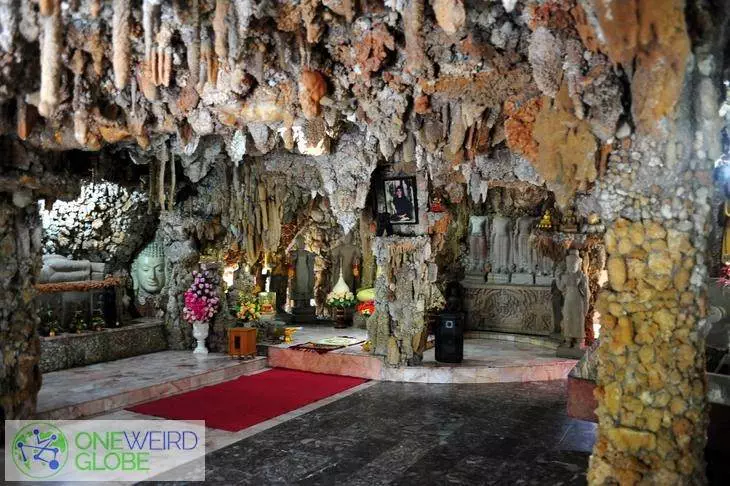
As a place to spend a weekend, Nakhon Ratchasima has a fair bit to offer the traveler to Isaan. Also commonly called ‘Korat’ from the two middle syllables (Na-KOn RATchasima), the city is in the southwest portion of Isaan and only a 3–4 hour bus ride from Bangkok. I’ll be covering a couple of other destinations in town in separate posts — for now, enjoy two oddball temples that are both well worth the visit.
Wat Phayap — the temple with a cave
Easily found in the northwest corner of Korat’s rectangular moat, Wat Phayap (pronounced ‘pa-yahp’) features a unique shrine with real stalactites and stalagmites. The abbot of the temple learned a beautiful cave in neighboring Saraburi Province was being blasted, so he rescued some of the cave’s more fascinating features. Once back at the temple, he remade the ground-floor shrine of his residence into a cave:

The result is a unique shrine — the stalactites were plastered to the ceiling…

…rocks to line the wall, and plenty of statues — including some floating Buddha heads.

As this is a functioning shrine, do keep quiet for the devout if they’re around.

The rest of the temple is relatively small — the statue of King Narai is worth noting, though. Reigning from 1656–1688, this Ayutthayan king rebuilt the city of Nakhon Ratchasima as a frontier city to guard against the Burmese invading along the Mekong. He also ordered the construction of the temple inside the city wall — monks aren’t able to spread the wisdom of Buddha if they’re killed during a war, after all.
As the cave-like shrine is the only notable building here, enjoy it — but if you’re not ready to move on within a half-hour I’d be surprised.
Wat Sala Loi — built by a local heroine
Thao Suranaree (also spelled Thao Suranari) is the local heroine commemorated with statues and parks. Also known as ‘Ya Mo’, or Grandmother Mo, she was the wife of the deputy governor of Nakhon Ratchasima. In 1826, the Vientiane King seized the area while the governor was away, Lady Mo is credited with attacking and harassing the Lao troops attempting to hold the city. After supposedly getting the soldiers drunk and acquiring knives, she helped prisoners escape their captors. In short order, King Rama III sent troops to defeat the Vientiane soldiers and destroy Vientiane.
She and her husband built the temple in 1827, and her relics are buried here.

In any case, the main temple building above is seen on a Chinese junk (boat), riding the waves. Personally, it’s not all that evident to me, though it did win an award relating to the modern design from the Siam Architects Society in 1973.

I love me some little baby Buddhas…

Remembering the dead — just one of dozens of statues.

Along with plenty of people performing their prayers (and a few women singing in the ‘Korat style’), a pair of figures freezes the fighting for history to preserve.
The story is nice and all, but the temple itself is nothing special. Feel free to make merit if you like — I’ve saved the best sights in Nakhon Ratchasima for their own posts, so stay tuned!
Name: Wat Phayap (also spelled Wat Payap) — the temple with a cave
Address: off of Chumphon rd. Mueang Nakhon Ratchasima District, Nakhon Ratchasima (GPS: 14.978552, 102.099318)
Directions: From Chumphon road at the northwest corner of the moat, make the U-turn (to go south). Go about 150 meters and take a left down the side road. Look for the temple on your right.
Hours: dawn-dusk
Admission: free (donations accepted)
Phone: none
Website: none
Name: Wat Sala Loi — built by a local heroine (วัดศาลาลอย)
Address: off Taosura 3 Alley, Muang Nakhon Ratchasima, Nakhon Ratchasima (GPS: 14.980617, 102.116566)
Directions: From the northeast corner of the moat, head east (straight if you’re on the northern road of the square). Head around 400 meters and look left for the temple.
Hours: 8:30am-4:30pm
Admission: free (donations accepted)
Phone: 044–213–030
Website: none


